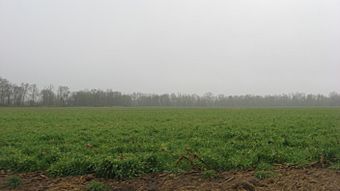Bieker-Wilson Village Site facts for kids
Quick facts for kids |
|
|
Bieker-Wilson Village Site
|
|

Fields at the site on a rainy day
|
|
| Location | Sandy Slough, southeast of the junction of County Road 300N and 1650E |
|---|---|
| Nearest city | New Haven, Illinois |
| Area | 40 acres (16 ha) |
| NRHP reference No. | 78001197 |
| Added to NRHP | November 21, 1978 |
The Bieker-Wilson Village Site is an archaeological site in the southeastern part of Illinois, a state in the United States. This ancient village was home to people for over five hundred years. Because of its history, it has been named a historic site.
Contents
Where is the Bieker-Wilson Site Located?
The Bieker-Wilson site is on flat land near the Wabash River. It used to be right next to the river. But over time, the river moved farther east. Now, an old part of the river is a slow-moving bayou called Sandy Slough.
Today, the site is farmland. It is about 2.5 miles (4.0 km) northeast of a small town called New Haven. This area has many other ancient sites. People lived here for thousands of years before Christopher Columbus arrived.
How Was the Site Discovered?
In the 1960s, there was a plan to build a big waterway. This project would have made the Wabash River easier for large boats to use. Before the project was stopped, the University of Illinois sent a team to survey the river valley.
Early Discoveries at Bieker-Wilson
In 1972, a team led by Robert Clouse found the Bieker-Wilson Site. Another scholar, Ronald Pulcher from Southern Illinois University, studied it more in 1973. They did not dig into the ground. Instead, they looked at the surface and collected ancient objects.
They noticed that a part of the site, about 4 acres (1.6 ha) wide, had much darker soil. This dark soil was a sign of a large midden. A midden is like an ancient trash pile, where people threw away their tools, food scraps, and broken pottery. This showed that a lot of people lived there for a long time.
What Did Researchers Learn About the Site?
Even without digging, the objects found on the surface helped experts learn about the people who lived at Bieker-Wilson. The site was used during the Middle and Late Woodland Periods. It was also used by people of the later Mississippian culture. This means people lived there for at least 500 years, and maybe even more than 1,000 years!
Who Were the Duffy Complex People?
Many other ancient sites from the Woodland period are nearby. Two of them are Hubele and Wilson, about 5 miles (8.0 km) northeast.
During the Late Woodland period, a group of people called the Duffy Complex lived near the Wabash River. Bieker-Wilson is one of the few places thought to be a Duffy village. We don't know much about the Duffy Complex because so few of their sites have been found. They made unique, plain pottery. But we are not sure how they fit in with other cultures of their time.
Why is Bieker-Wilson Important for Research?
The early studies at Bieker-Wilson showed that Duffy people lived there. This makes the site very important. If archaeologists could dig into the large midden, they might learn much more about this mysterious culture.
The site was also used a little during the Middle Woodland period. It might have been a place for making stone tools or a temporary camp. Even small clues from this time could teach us more about Middle Woodland campsites.
Finally, because the site was used by different groups over many years, it could help answer big questions. For example, how did the Late Woodland people change and become part of the Mississippian culture? Bieker-Wilson might hold the answers to these important questions about ancient history.
How is the Site Protected?
After the site was found, it was kept in good condition by its owner, who used it as farmland. There was no major damage.
National Register of Historic Places
To give the site more protection, the Illinois Archaeological Survey applied to have it listed on the National Register of Historic Places. This happened in November 1978.
Being on the National Register does not stop private owners from using their land. But it does mean that federal agencies cannot damage the site without a long review process. Bieker-Wilson is one of eleven places in White County on this special list. The Hubele and Wilson village sites are also on the list. Most of the other sites are in the city of Carmi.



